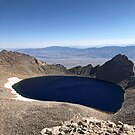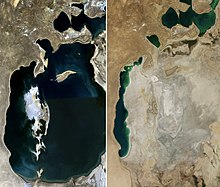Portal:Lakes
The Lakes Portal
A portal dedicated to Lakes
Introduction

A
Lakes are typically larger and deeper than
Natural lakes are generally found in
Selected article -
The Aral Sea (/ˈærəl/ ARR-əl) was an endorheic lake lying between Kazakhstan to its north and Uzbekistan to its south which began shrinking in the 1960s and largely dried up by the 2010s. It was in the Aktobe and Kyzylorda regions of Kazakhstan and the Karakalpakstan autonomous region of Uzbekistan. The name roughly translates from Mongolic and Turkic languages to "Sea of Islands", a reference to the large number of islands (over 1,100) that once dotted its waters. The Aral Sea drainage basin encompasses Uzbekistan and parts of Afghanistan, Iran, Kazakhstan, Kyrgyzstan, Tajikistan, and Turkmenistan.
Formerly the third-largest lake in the world with an area of 68,000 km2 (26,300 sq mi), the Aral Sea began shrinking in the 1960s after the rivers that fed it were diverted by Soviet irrigation projects. By 2007, it had declined to 10% of its original size, splitting into four lakes: the North Aral Sea, the eastern and western basins of the once far larger South Aral Sea, and the smaller intermediate Barsakelmes Lake. By 2009, the southeastern lake had disappeared and the southwestern lake had retreated to a thin strip at the western edge of the former southern sea. In subsequent years occasional water flows have led to the southeastern lake sometimes being replenished to a small degree. Satellite images by NASA in August 2014 revealed that for the first time in modern history the eastern basin of the Aral Sea had completely dried up. The eastern basin is now called the Aralkum Desert.
In an effort in Kazakhstan to save and replenish the North Aral Sea, the Dike Kokaral dam was completed in 2005. By 2008, the water level had risen 12 m (39 ft) above that of 2003, to 42 m (138 ft). , salinity dropped, and fish were again present in sufficient numbers for some fishing to be viable. (Full article...)General topics
| Lake zones |
|---|
| Lake stratification |
|
| Lake types |
| See also |
- List of lakes
- Limnology
- Lake ecosystem
- Lake stratification
- Ancient lake
- Former lake
- Shrunken lake
- Salt lake
- Lava lake
- Reservoir
- Lakes of Titan
Need assistance?

Do you have a question about lakes that you can't find the answer to? Consider asking it at the Wikipedia reference desk.
General images -
-
synthetic aperture radar mosaic (from Lake)
-
An artist's depiction of the subglacial lakes and rivers beneath the Antarctic Ice Sheet. Image credit: Zina Deretsky / US National Science Foundation (from Subglacial lake)
-
The Nowitna River in Alaska. Two oxbow lakes – a short one at the bottom of the picture and a longer, more curved one at the middle-right. (from Lake)
-
Crater Lake in Oregon, USA (from Volcanogenic lake)
-
A view of the southern polar plain of Mars. The area where a subglacial lake has been detected is highlighted. Image credit: USGS Astrogeology Science Center, Arizona State University (from Subglacial lake)
-
Lake Mapourika, New Zealand (from Lake)
-
Soda Lakes in Nevada, USA (from Volcanogenic lake)
-
Russian scientist Peter Kropotkin first proposed the idea of fresh water under Antarctic ice. (from Subglacial lake)
-
Garibaldi Lake in British Columbia, Canada, is impounded by lava flows comprising The Barrier (from Volcanogenic lake)
-
Cross sectional diagram of limnological lake zones (left) and algal community types (right) (from Lake)
-
Ice melting on Lake Balaton in Hungary (from Lake)
-
The first view of the sediment at the bottom of subglacial Lake Whillans, captured by the WISSARD expedition. Image credit: NASA/JPL, California Institute of Technology (from Subglacial lake)
-
An illustration of ice core drilling above subglacial Lake Vostok. These drilling efforts collected re-frozen lake water that has been analyzed to understand the lake's chemistry. Image credit: Nicolle Rager-Fuller / US National Science Foundation (from Subglacial lake)
-
West Coast region of New Zealand. (from Lake)
-
Lava lake at Mount Nyiragongo in the Democratic Republic of the Congo (from Volcanogenic lake)
-
A schematic cross-section of the subglacial pool beneath Taylor Glacier and its outflow, Blood Falls. Image credit: Zina Deretsky / US National Science Foundation (from Subglacial lake)
-
Ephemeral 'Lake Badwater', a lake only noted after heavy winter and spring rainfall, Badwater Basin, Death Valley National Park, 9 February 2005. Landsat 5 satellite photo (from Lake)
-
Ludington Lighthouse (from Lake)
-
View of Lake Toba in Sumatra, Indonesia which is the largest volcanic lake in the world (from Volcanogenic lake)
-
Round Tangle Lake, one of the Tangle Lakes, 2,864 feet (873 m) above sea level in interior Alaska (from Lake)
Related portals
WikiProjects

- WikiProject Lakes
- WikiProject Rivers
- WikiProject Oceans
- WikiProject Water
Categories
More articles
Associated Wikimedia
The following Wikimedia Foundation sister projects provide more on this subject:
-
Commons
Free media repository -
Wikibooks
Free textbooks and manuals -
Wikidata
Free knowledge base -
Wikinews
Free-content news -
Wikiquote
Collection of quotations -
Wikisource
Free-content library -
Wikiversity
Free learning tools -
Wiktionary
Dictionary and thesaurus
External media

- World Lake Database. International Lake Environment Committee Foundation. – provides a searchable database
- Global Lakes and Wetlands Database. World Wide Fund for Nature. – available for free download























































